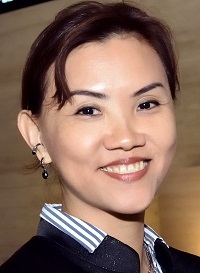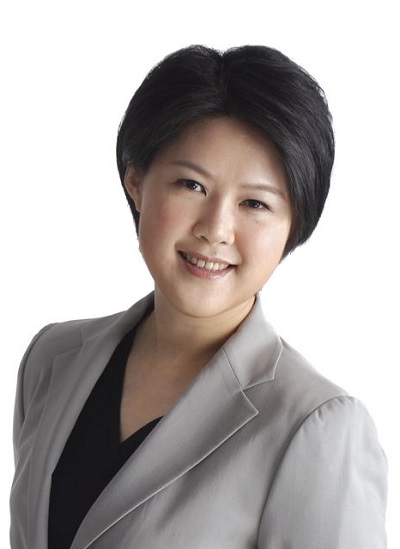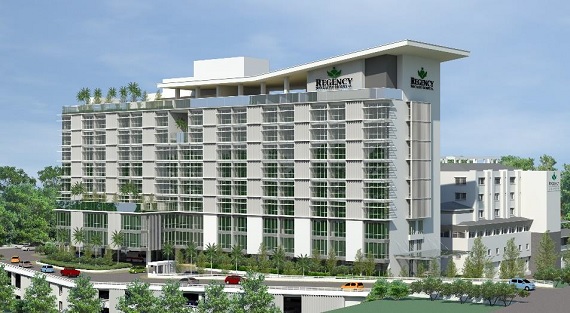 This article, written by Jennifer Tan (left, Director, Research & Products, Equities & Fixed Income, at the Singapore Exchange), originally was published on SGX My Gateway kopi-C. The article is republished here with permission.
This article, written by Jennifer Tan (left, Director, Research & Products, Equities & Fixed Income, at the Singapore Exchange), originally was published on SGX My Gateway kopi-C. The article is republished here with permission.
|
 “I believe HMI's value comes through contributing to the wider community. As healthcare providers, we're not just a for-profit business - we're also providing services for the betterment of the communities we operate in.” “I believe HMI's value comes through contributing to the wider community. As healthcare providers, we're not just a for-profit business - we're also providing services for the betterment of the communities we operate in.”
- Chin Wei Jia
Group CEO
Health Management International
(Photo: Company)
|
For photography buff Chin Wei Jia, one of the most memorable images she captured was that of a Vietnamese family houseboat, packed with people, livestock and laundry, gliding on the river's calm surface, soaking up rays of the late afternoon sun.
"I took that photo on my phone, during a sampan ride in Da Nang, just outside the city. It's one of my favourites, because it was a snapshot of a family living their life, in their home," said Chin, the Group Chief Executive Officer of SGX-listed private healthcare provider Health Management International (HMI) Ltd.
"In photography, it's all about capturing that particular moment, and through travel, you learn about different perspectives. It's the same in the healthcare industry - we need to be able to put ourselves in someone else's shoes, in this case, the patients, and look at providing the service from their perspective," she added.
Chin's passion for healthcare is embodied in HMI's vision of improving the lives of patients through quality services.
"I believe HMI's value comes through contributing to the wider community. As healthcare providers, we're not just a for-profit business - we're also providing services for the betterment of the communities we operate in," she said.
HMI first began operations in Singapore in 1991 through HMI Balestier Hospital, formerly known as Balestier Medical Centre. In 1998, it acquired a stake and a five-year management contract in Mahkota Medical Centre, a loss-making hospital in Malacca, after which it carried out a restructuring exercise to turn the facility around. A year later, HMI listed on Singapore Exchange's smaller board, then known as Sesdaq.
Chin joined HMI in 2002 as a management trainee, after a phone call from her mother, Executive Chairman Dr Gan See Khem. At the time, the Master of Arts graduate in International Relations from Johns Hopkins University was considering doing her PhD or applying for a job in a multinational corporation.
"When Mum called, she said, 'We're restructuring HMI, please come back.' So I packed up, returned to Singapore, and was thrown into the thick of things," the 38-year-old recalled with a grin.
|
Going Regional
HMI adapted the Singapore private hospital business model for use in Malaysia. Mahkota was one of the first hospitals across the Causeway to sell medical suites to doctors, and also one of the early movers in attracting patients from Indonesia.
|
HMI
|
|
Stock Price
|
41.5c
|
|
Market Cap
|
S$236.2 million
|
|
52-week high low
|
25c to 43.5c
|
|
Dividend Yield
|
-
|
|
PE ratio
|
30.9x
|
|
Source: SGX StockFacts
(data as of 24 Aug 2016)
|
Mahkota began operations in 1994, but HMI came in from 1998 to manage the loss-making facility, and successfully achieved a turnaround within a few years. Today, Mahkota is one of Malaysia's most profitable hospitals, and a recognised medical tourism hub in the country.
After growth opportunities for a secondary-care hospital in Singapore were crimped by the fallout from the 1998 Asian Financial Crisis, HMI Balestier Hospital was converted to the HMI Institute of Health Sciences by 2005 to provide healthcare education and training.
"The spending power of both local and regional patients was severely impacted by the crisis, while patient loads in domestic secondary-care hospitals shrank due to increased capacity from upgraded-restructured hospitals," Chin said.
"That was when we made the decision to exit the local healthcare market and go regional."
Spotting the huge potential in the Malaysian healthcare market, HMI subsequently acquired a stake in Regency Specialist Hospital, a then-empty hospital building in east Johor, in 2007. Regency's patient load grew rapidly, and it achieved its first full-year of profitability in 2014, nearly five years after it started operations.
"We're focused on providing the middle-income segment with value-for-money and quality healthcare, ensuring our patients receive good treatment and service," said Chin, who was appointed Group CEO in September 2015.
|
“We want them to feel they can come to our hospitals and resolve most, if not all, their problems, rather than be referred somewhere else.”
- Chin Wei Jia
Group CEO
Health Management International
|
"Our business model centres on partnering doctors in the industry, as they are independent practitioners, and through these partnerships, growing together with them. After all, doctors are the key reason why patients come to hospitals."
HMI, which was upgraded to the SGX Mainboard in 2008, aims to develop and build comprehensive tertiary hospitals offering specialty and sub-specialty services. It essentially offers a one-stop shop for patients to get diagnosed and treated for a wide range of medical conditions at its facilities.
"We want them to feel they can come to our hospitals and resolve most, if not all, their problems, rather than be referred somewhere else," Chin added.
With this in mind, one key characteristic of HMI hospitals is same-day surgeries, which help save time and limit travel costs for foreign patients. Its key patient pool in Mahkota Medical Centre comprises 75% locals, with the remainder primarily from Indonesia.
Last year, hospitals in Malaysia saw an influx of 850,000 foreign patients, with Mahkota accounting for about a 10% share. "During the downturn, some hospitals in Malaysia see fewer patients, but HMI facilities continue to enjoy increased patient loads - that's because we're adding value," she noted.
| ♦ Burgeoning Growth |
|
HMI has a current market capitalisation of about S$250 million. Its shares have registered a dividend-inclusive total return of 26.1% in the year-to-date, compared with 1.8% for the benchmark Straits Times Index (STI), and 2.2% for the 27-constituent SGX All Healthcare Index. This makes HMI the fourth-best performing component stock in the SGX All Healthcare Index.
Between the financial years ended 30 June 2011 and 2015, the company grew its revenues from 174 million ringgit (S$58.2 million) to 345 million ringgit (S$115.5 million), reflecting a compound annual growth rate (CAGR) of 19%. Its profit after tax rose from 2 million ringgit to 28 million ringgit over the same period - a CAGR of 98%, data from annual reports showed.
 Construction of HMI's new 10-storey medical block that will expand its Regency Specialist Hospital is expected to commence next year and be completed in 2019. Artist's impressionHMI's key assets comprise two tertiary hospitals - the 288-bed capacity Mahkota Medical Centre and the 218-bed capacity Regency Specialist Hospital. It has more than 170 practising consultants serving close to 400,000 patients per annum. Construction of HMI's new 10-storey medical block that will expand its Regency Specialist Hospital is expected to commence next year and be completed in 2019. Artist's impressionHMI's key assets comprise two tertiary hospitals - the 288-bed capacity Mahkota Medical Centre and the 218-bed capacity Regency Specialist Hospital. It has more than 170 practising consultants serving close to 400,000 patients per annum.
Its main competitors include IHH Healthcare Bhd, KPJ Healthcare Bhd, Ramsay Sime Darby Health Care and other independent tertiary hospitals.
Meanwhile, the region's healthcare needs continue to rise unabated.
"We have ageing demographics, rising affluence, a greater knowledge and awareness of medical care, as well as increasing local insurance penetration. All of these will drive robust growth in the industry over the longer term," Chin noted.
In the case of Malaysia, it has a two-tiered healthcare system - split roughly 50:50 between private and public spending. By 2025, total healthcare expenditure in Malaysia could exceed US$20 billion, while from 2015 to 2020, it is expected to show a CAGR of 11%, according to data from Frost & Sullivan.
The country's healthcare expenditure accounted for 3.9% of gross domestic product in 2013, well below the global average of around 6.5%, and the ASEAN average of about 4.3%.
"Malaysia still has a lot of room for growth. It is a severely underserved healthcare market, with a significant shortfall of beds," Chin pointed out.
|
| ♦ Invest and Innovate |
|
Medical tourism will also be another key growth driver for the healthcare sector, as the country is viewed as a target destination by Indonesian patients.
"Due to the ringgit exchange rate, Malaysia as a healthcare destination is very price-competitive versus the rest of Asia," Chin added.
Between 2011 and 2014, the number of medical tourists to Malaysia increased from 641,000 to 882,000 per year. In 2014, medical tourism brought in revenues amounting to 730 million ringgit from more than 880,000 arrivals. The country's medical tourism market is expected to expand at a CAGR of 18.5% between 2014 and 2020, according to estimates from Frost & Sullivan.
|
“Due to the ringgit exchange rate, Malaysia as a healthcare destination is very price-competitive versus the rest of Asia.”
- Chin Wei Jia
Group CEO
Health Management International
|
Key drivers for the medical travel industry in Malaysia include accessibility to medical destinations, reasonable healthcare costs, the availability of high-quality treatment, and advanced medical infrastructure.
Looking ahead, HMI plans to boost bed capacity in both Mahkota and Regency to cater to rising patient demand, as well as develop centres of excellence, such as cancer treatment facilities.
The Group will also grow its presence in the private hospital market through new investments, focusing on Southeast Asia, and replicating the successful business models of Mahkota and Regency. At the same time, it is seeking other suitable healthcare-related business opportunities in the region.
"We are investing continuously to deliver the best-quality, holistic services to our patients, with a focus on innovation so that we keep abreast of the latest technology and treatment trends in the field," Chin noted.
"You could say we're in a constant state of renewal."
Challenges, however, abound in this industry, which is one of the most heavily regulated in the world. "Competition will continue to increase, while shortages of doctors and specialists remain acute," she added.
Escalating costs is another bugbear. "Operating expenses are inflated by higher import fees from the ringgit exchange rate, while wages continue to increase. These pressures are manageable for now, as we've achieved economies of scale and cost efficiencies throughout the Group, but I expect this to become more of a challenge going forward," she admitted.
Despite the difficulties, Chin finds inspiration in making a positive impact on people's lives. Having studied international relations, "there's a part of me that wants to save the world," she grinned.
"At the end of the day, it's all about patient satisfaction. Our whole business is built around giving patients quality care and treatment, and each single experience is important to us," she said.
"Through HMI - our doctors and staff, I believe we're able to make a difference. This is the one thing that keeps me going, pushes me to do more, and to do better."
|
| Year ended 30 June (RM '000) |
FY2015 |
FY2014 |
FY2013 |
FY2012 |
| Revenue |
345,224 |
292,912 |
245,415 |
209,221 |
| Profit before tax |
54,763 |
46,199 |
26,068 |
12,128 |
| Net attributable profit |
27,643 |
16,027 |
7,574 |
-481 |
Quarter ended
31 March (RM '000) |
3QFY2016 |
3QFY2015 |
YoY change |
| Revenue |
100,879 |
82,911 |
21.7% |
| Profit before tax |
19,881 |
11,115 |
78.9% |
| Net attributable profit |
8,669 |
7,725 |
12.2% |
| ♦ Outlook |
- Although the healthcare landscape in Malaysia remains competitive with the emergence of new hospitals, a healthy rising trend in domestic insurance penetration, ageing demographics and increasing regional connectivity are expected to contribute to the growth of private healthcare services.
- A recent New Straits Times article reported that medical tourism in Malaysia is also expected to expand, as more foreigners are travelling to seek a variety of treatments across the cost spectrum. Malaysia remains an attractive destination for medical tourists, due to the availability of competent medical staff and high-quality facilities in the country.
- Both Mahkota Medical Centre and Regency Specialist Hospital continue to attract increasing numbers of patients due to the comprehensive range of quality healthcare services offered. With increasing occupancy in its hospitals, HMI has commenced expansion plans to accommodate the Group's future growth.
|
Health Management International Ltd
Established in 1998, Health Management International Ltd (HMI) is a fast-growing private healthcare provider with presence in Singapore, Malaysia and Indonesia. The Group's key assets comprise two tertiary hospitals in Malaysia - the 288-bed capacity Mahkota Medical Centre in Malacca and the 218-bed capacity Regency Specialist Hospital in Johor. The Group also owns and operates the HMI Institute of Health Sciences in Singapore, which provides healthcare training and education. HMI, which listed on Singapore Exchange's Sesdaq second board in 1999, was upgraded to the Mainboard in 2008.
The company website is: www.hmi.com.sg
Click here for the company's StockFacts page.
For fiscal third quarter ended 31 March 2016 results, click here.
 This article, written by Jennifer Tan (left, Director, Research & Products, Equities & Fixed Income, at the Singapore Exchange), originally was published on SGX My Gateway kopi-C. The article is republished here with permission.
This article, written by Jennifer Tan (left, Director, Research & Products, Equities & Fixed Income, at the Singapore Exchange), originally was published on SGX My Gateway kopi-C. The article is republished here with permission.







